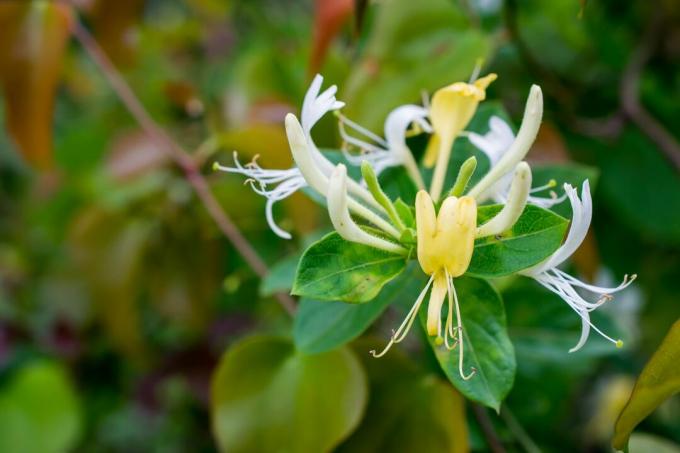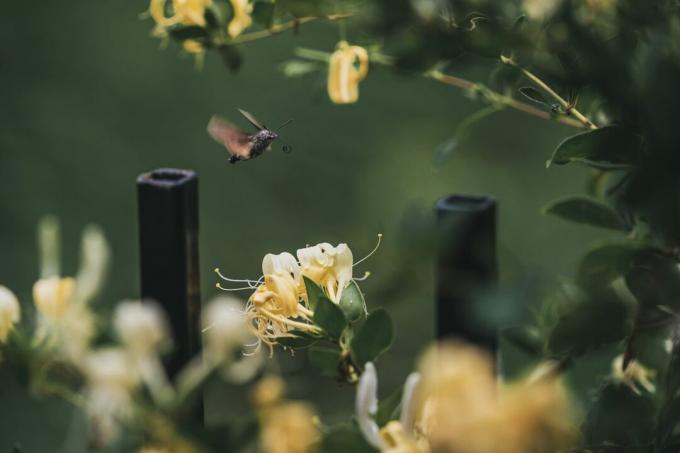Jelängerjelieber is an insect-friendly, fragrant creeper. You can find out from us how to properly plant and care for the climbing plant with the unusual name.

The creeping Jelongerjelieber inspires with strong growth and fragrant flowers. In the following we show everything about the location requirements, planting, care and propagation of the honeysuckle.
"Contents"
- Jelängerjelieber: origin and properties
- The most beautiful Jelängerjelieber varieties
- Planting garden honeysuckle
- Care for the longer jelly: cut, fertilize and co.
- The longer the better multiply
- Is the Jelongerjelieber poisonous?
Jelängerjelieber: origin and properties
The Jelongerjelieber (Lonicera caprifolium) is also known as garden honeysuckle, real honeysuckle or fragrant honeysuckle. The perennial, hardy climbing plant belongs to the honeysuckle family (Caprifoliaceae). It is native to large parts of Europe and the Near East and can be found growing wild in hedges or sparse forests.
The woody plant, between 3 and 6 m, in exceptional cases 10 m high, is deciduous and loses its leaves in winter. With increasing age, the creeper reaches a width of 1 to 3 m. The Jelängerjelieber shows strong growth and increases the shoot length by 30 to 50 cm per year. The dark green leaves of the honeysuckle are opposite, ovate-elliptical and tapering in shape. The top leaves of each shoot have grown together below the inflorescence to form a stalk-encompassing disc.
Up to twelve trumpet-shaped individual flowers together form a terminal, whorled flower head. The flowers of the Jelongerjelieber appear between May and July. They are white to yellow in color and red to pink depending on the variety. Especially in the evening hours, the flowers of the garden honeysuckle give off a strong scent and attract numerous moths and hawk moths such as the hummingbird-like pigeon (Macroglossum stellatarum) at. During the day, bees, bumblebees and other short-snouted insects also use the flowers, which are particularly rich in nectar, by poking a hole in the side of the long flower. In autumn, the seeds ripen into pea-sized, orange-red berries. Birds eat the honeysuckle fruits, which are mildly poisonous to mammals, and spread the seeds further.

The most beautiful Jelängerjelieber varieties
the kind Lonicera caprifolium is usually sold as a prototype without specifying the variety. However, there are a few varieties that have been bred that we would like to introduce to you.
- 'Anna Fletcher': Earliest garden honeysuckle variety with creamy yellow, pink-orange tinged buds from April to May. It can grow up to 6 m high.
- 'inga': Jelongerjelieber variety with a late flowering period from June to September. The yellow-cream white flowers are reddish as closed buds. 'Inga' reaches heights of growth of 3 to 5 m.
- 'Major': Medium late flowering variety with light yellow and red colored, strongly scented flowers. 'Major' starts flowering in June.
Tip: An equally insect and bird friendly evergreen alternative is the related species Lonicera henryi with yellow to red flowers.

Planting garden honeysuckle
The honeysuckle is ideal for greening pergolas, trellises, fences and facades. The optimal location for the Jelängerjelieber is in a sunny to lightly shady position and on permeable, fresh to moist, nutrient-rich and humus-rich soil. The pH value should be between the neutral and alkaline range, because the creeper loves lime. Since most garden soils and potting soil have a slightly acidic pH value, it is advisable to apply garden lime. For this purpose, fine-grained garden lime should not be used, because other types of lime can corrode plant roots and soil organisms or work much too slowly. A good choice is ours, for example Plantura organic garden and lawn lime, whose chemical form does not work too quickly, but which nevertheless reliably increases the pH value due to the fine degree of grinding.
Tip: In the shade with little light, the garden hot leaf forms little or no flowers.
The ideal planting time for Jelängerjelieber is in autumn or early spring when the ground is frost-free. The planting distance between two honeysuckles for a dense vegetation is 50 cm, to other plants a distance of 100 cm should be maintained. Loosen the soil at the future location and work in some compost if necessary. Heavily sandy soils can be improved with a good quality potting soil to retain more moisture. Dig a sufficiently large planting hole and put the root ball of the creeper into it. Fill up with soil and press down the substrate all around. Then water vigorously. Lead the shoots of the Jelängerjelieber to the trellis and twist them around slightly so that they climb up.

The Jelängerjelieber is well suited for planting in pots and balcony boxes. The soil volume of the planter should hold at least 40 liters in order to be able to cultivate the climbing plant in it for several years. We recommend using a good quality potting soil such as our peat-free Plantura organic universal soil. The high compost content stores moisture and releases it to the plant roots when needed. In order to further increase the water storage capacity, bentonite can also be added.
Jelongerjelieber plants at a glance:
- Well-drained, nutrient-rich and humus-rich soil with a neutral to alkaline pH
- Sunny to semi-shady location
- Planting time: In autumn or early spring when the ground is frost-free
- Planting distance: 50 cm between two honeysuckles, to other plants 100 cm
- Loosen soil and work in compost if necessary; improve very sandy soils with potting soil
- Dig a sufficiently large planting hole and place the root ball in it
- Fill the hole with soil and press down lightly
- Water vigorously and support shoots with a climbing aid
- Plant in a pot or balcony box with a volume of at least 40 liters and high-quality potting soil
Care for the longer jelly: cut, fertilize and co.
The honeysuckle is easy to care for and blooms happily in sunny locations. If the Jelängerjelieber does not bloom, this can also be due to spring drought or a lack of nutrients - apart from the light supply. With prolonged drought, the honeysuckle should be watered regularly. A layer of mulch also reduces evaporation and keeps the root area of the climbing plant cool and moist. In order to cover the nutrient requirements of the vigorous creeper, you should fertilize your jellyfish in the spring. A predominantly organic long-term fertilizer, like ours Plantura organic universal fertilizer, is ideal for this. The granules are worked into the surface around the plant or simply under the mulch layer distributed and the nutrients contained are slowly absorbed by soil organisms over weeks and months released.
Cutting the Jelongerjelieber is not absolutely necessary. After flowering, the shoots can be shortened to encourage a second flowering in the fall. With age, the branches begin to bare from below. When pruning for rejuvenation every three to four years, take out about a third of the oldest shoots completely to encourage new growth. If you keep your Jelängerjelieber in a bucket, you should think about insulating winter protection made of fleece, jute or conifer branches in late autumn. The roots are much more exposed to the cold and frost in the pot than in the bed and can be damaged more easily.

The longer the better multiply
The garden honeysuckle can be propagated by seed, layering or cuttings. The seeds are in the poisonous berries, so wear gloves when sowing. The seeds are freed from the pulp and sown about 0.5 cm deep in nutrient-poor potting soil and germinated at 18 to 20 °C. After about four weeks, the first tender plants appear. As soon as four real leaves have formed, the honeysuckle can be planted out. Propagation via layering and cuttings is easier, faster and true to the variety.
sinker: In the fall, bend down a shoot that has not yet lignified and score the future one Lightly mark the rooting point with a knife and cover it with soil, leaving only the top looks out. A rock or piece of wood acts as a weight to keep the shoot in the ground. Once roots have formed, the sinker can be cut off and moved.
cuttings: Cuttings are cut from the soft, green shoot tips. They should have at least three buds and be about 10 to 15 cm long. Remove all but the top of the leaves and any flower buds. Then put the piece of shoots in moist potting soil, half of which has been enriched with sand and a little lime, and leave it in a bright, approx. Root in a warm place at 20 °C.

Is the Jelongerjelieber poisonous?
The orange-red berries of the honeysuckle are mildly toxic to humans and other mammals. Excessive consumption can lead to vomiting, cramps, dizziness and other symptoms of intoxication. However, the Jelängerjelieber always had a meaning in medicine, because the dried flowers were administered in folk medicine as a water-driving agent. In principle, however, we would like to advise against the consumption of any plant part of the honeysuckle.
Greening for many years hardy climbing plants house walls or pergolas. We present ten climbing, perennial species for your garden.



